Because of what it represents, the Dragon is one of the most important symbolic animals in Chinese culture, a fact that comes to mind when considering some aspects of Macanese life and the urgent need to gather and reorganise it in its entirety. In the East, the Dragon is not seen as a monster, as it was during Medieval times in the West, but as the spirit of Goodness and Strength and the symbol of Change. 'The greatest animal in the World', that hides in caves set deep in the mountains or sea and which is transformed by its 'new appearance', whether visible or invisible, is feared and respected...
Just like the Dragon that hides one minute and appears the next, brightly coloured and mysterious before our innocent eyes, Macanese cultural expression never ceases to surprise. It too, like the monster, ascends to Heaven or lingers in deep waters. The gestures that personify it reveal parts of its magnificent, shining body that have yet to be exposed. This is why we are trying to make it known. Time races by and very soon Macanese culture could disappear forever in the sepia-coloured waters of the Pearl River or into the sky, like the smoke from New Year panchões (Chinese firecrackers).
Moving on from this image, we can consider the present status of Macanese culture. For a long time its Patrimony was not directly collected and when collecting began there were many difficulties. Marques Pereira, among others, confirms this in the magazine that he ran, "Ta-Ssi-Yang-Kuo, Arquivos e Anais do Extremo-Oriente".1 Although circumstances have changed since then, there is a long trail to be followed in libraries and in private, national and foreign collections in order to find out from studies that have since been published and from the research done in fields that until recently were unexplored. Although the Bibliografia Macaense2 is an extremely useful tool to work from, there is still much to be done. Diffuse documents need to be compiled and catalogued, collections of critical works need to be organised and the cultural heritage, that is on its way to extinction, needs to be recovered.
As has been shown in bibliographical works3 and other genres (especially literary), original documentation concerning Macanese culture was not plentiful until the nineteenth century. Graciete Batalha is, for example, surprised by the lack of works of fiction and maintains she does not know of any poetical evidence prior to the nineteenth century4. The difficult history of Portuguese residency in Macao, 5 the isolation, the miscegenation, the Official Language and the 'spoken' Language, should all be pointed out as being amongst the indicated causes for this state of affairs. So too should the diversity of cultures and cultural models, of which some were as different as Chinese is from Portuguese. Other cultures should not be forgotten since people from India, Malaysia, Timor, Japan and Africa took shelter in this land.
Extracting the 'gangue' from this melting pot of cultures and races or, in other words, finding the seeds, roots and fruits from within it, is a lengthy and complex task, although some results can be obtained from thorough examination along the trail of so many researchers and literary figures of merit.
Since the nineteenth century which, in effect, witnessed the appearance of several writers who originated in Macao or the Motherland and through whom we got to know the many facets of the region as well as those of China, be it by literary and historical channels or by ethnographical, anthropological, social and political ones. Beltrão Coelho, Fr. Benjamim Videira Pires, Camilo Pessanha, Cecília Jorge, the Count of Arnoso, Danilo Barreiros, Deolinda da Conceição, Feliciano António Marques Pereira, Francisco de Carvalho e Rêgo, Henrique de Sena Fernandes, João de Pina Cabral, José Maria (Jack) Braga, Luís Gonzaga Gomes, Manuel da Silva Mendes, Fr. Manuel Teixeira, Nelson Lourenço and Venceslau de Morais, are the names that immediately spring to mind.
Alda de Carvalho Ângelo does not appear in this list. Gonzaga Gomes refers to one of her books, Fragmentos do Oriente (Contos, Viagens, Culinária) (Fragments of the East (Tales, Travels and Cuisine)), in his Bibliografia Macaense. 6 As far as is known, there is no other reference to the writer. Various explanations can be given for this: her seclusion in remote locations in Brazil, her late emergence as a writer in Macao and the still incomplete Macanese bibliography that meant a complete reconstitution of relevant material was impossible... Up until now Alda Ângelo almost went unnoticed. Nevertheless her books form an important contribution to Macanese culture.
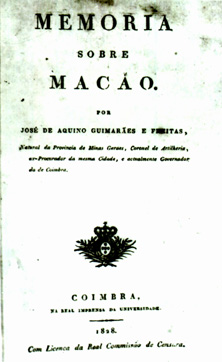
The cultural and everyday life of this woman were both rich and varied. She lived and participated in the cultures of three different Continents and four different races: Portuguese, Macanese, Chinese and Brazilian. From a very early age until adulthood she lived in Macao, during times of peace as well as during turbulent times of war when Hong Kong was invaded by the Japanese and many refugees went to the City of the Pearl River. She was born in Kowloon, 7 and lived there for a while, but she attended Primary and Secondary School in Macao. She lived there until she got married in 1941 when she returned to live in the town of her birth, but left there under tragic circumstances in 1942. Her husband enlisted as a volunteer during the War against the Japanese and ended up a prisoner of War in the Sam-Shui-Poo concentration camp where he appears to have died. Widowed within three months of her marriage, Alda stayed in Kowloon for a mere eight months after these events, whose traumatic episodes she related to us. She spent a short time in Lisbon en route to São Paulo, Brazil, where she finally settled.
She came from a large family of eight children. She tells us in detail of the places she lived in Macao, her road where more Indian-Chinese lived than nationals of the Motherland. She later tells of the happy friendship that united the neighbours of different race and nationality, of her dislikes, of her daily experiences, of the type of education she received with her Chinese governess, (which were found in most Macanese households). Her parents should be thanked for her multi-cultural and ethnic openness and acceptance. The whole family is referred to in her writings. Her father was Portuguese, from Vila Real [Province of Trás-os-Montes], but as a young boy was taken to Macao which he adopted as his home, living there until he died. Her mother, who was from Macao, 8 married very young and brought up numerous offspring. Her Chinese governess, or amah, did not just fulfil the role she was expected to, she also left an important legacy in the form of Chinese Language, habits and customs, stories and songs from the opera and theatre and even from the rich tapestry of everyday life. Alda's inquisitive and intelligent mind knew how to judiciously organise 'places, times and cultures'. She puts all this across to the reader in a lively and familiar style, while recreating scenes and events from life. A Brazilian influence can be seen in the Language; the way she expresses herself, the constructions she uses and even perhaps in the spontaneity.
Everything can be found in this work full of understanding and humanity: the very personal or the very intimate; the very general or the very particular; reflections of an ethnographical nature (on a variety of aspects to do with Macanese and Chinese traditional cuisine, dress, customs and habits), of historical, meteorological and demographical nature. After having lived in the East for nearly thirty years, between the Cidade do Nome de Deus de Macau, Hong Kong and Kowloon, with either friends or relations or on her own, she became known as a writer, translator and contributor to monthly publications in Brazil, her adopted Country where she emigrated to in about 1946. She distinguished herself in a number of fields and was interested in many areas especially the theatre, in this South American Country. She was a member of various professional societies of journalists, writers and theatre people. But none of this seemed to have any resonance in Macao. The distance between Alda and her Homeland and compatriots would not have helped to strengthen links with the other side of the World, the East. And so she escaped notice in this land. There has been a great deal of dispersion from Macao, but the majority of its 'children' do not forget their Homeland: some return, others visit on nostalgic trips, others still write about Macao and dedicate their intellectual studies to it. This is what happened in the case of Alda de Carvalho Ângelo. Her work shows many different, interesting sides, from translations to a collection of papers that indulge in reflections on the different aspects of Macanese and Chinese life and how these cultures are perceived. At times she also refers to Indian life and culture, but not in such depth.
Of Alda Ângelo's various books, we shall look at two in greater detail: Maravilhas do conto chinês (Wonders of Chinese Tales)9 the title of the first edition, and Fragmentos do Oriente (Contos, Viagens, Culinária)10 from 1965. With these two books the reader will be faced with two problems that are still relevant today: translation and cultural exchange. Due to the complexity of the Language, Chinese Literature was only ever read in translation. The translations are imperfect today and were even more so thirty years ago. For this reason, it should be emphasised how important Alda Ângelo's translations were, at a time when they were almost non-existent where Portuguese was concerned. It was not the same for the English Language. Thanks to the initiative of Chinese publishers and English intellectuals, like Gladys Yang, who belonged to Hong Kong society, the reader has had at his disposal, for a long time, an enormous repertoire of Chinese books on a diversity of subjects. Contrary to this, it would appear that the Portuguese and Chinese communities' need or enthusiasm to deepen their knowledge of each other was minimal. Neither Portuguese nor Chinese Literature were extensively translated into foreign Languages. As I have mentioned elsewhere, 11 the Chinese and Portuguese, despite being such close neighbours, made there own separate ways in Macao. Efforts have since been made to rectify this situation which is so damaging for both sides.
By about 1971, a slight increase in translation work in China can be seen, despite the true cultural opening only taking place around 1980. Publications are appearing that cover politics, Literature, history, martial arts, children's Literature, chronography of the People's Republic of China, etc. Curiously, it is at about the same time in Portugal, the Seventies, that a period of a substantial increase in translations of Chinese Literature begins. The coup d'état of the 25th April 1974 marked the moment when Portuguese interest in this culture was unleashed. Oddly, traditional Literature also took up a key position in both Countries. Many Chinese books of a fictional nature were translated at this time, in China, as well as in Portugal.
If, however, this was the most important period in the history of translations from Chinese to Portuguese, previous endeavours that added to the understanding and knowledge of traditional Chinese Literature can not be ignored. For example, Silvina Gomes, helped by a Chinese Ambassador, considers herself amongst these pioneers. Her contribution, along with those of a few others, kept countering the progressive lack of interest and contact with the other. The same thing occurred in Brazil, but more specifically in São Paulo where Alda de Carvalho Ângelo lived. Maravilhas do conto chinês12 was published there at an unknown date. Other publications followed. The most recent is entitled Contos chineses13 (Chinese Tales) and is part of the Universidade de Bolso collection of World anthologies and short stories.
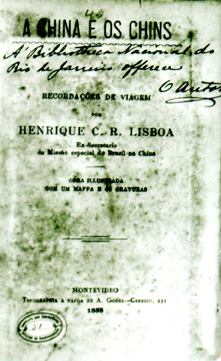
The various different publications illustrate the interest for this type of Literature in Latin America, but we do not know if they are all identical. It was very difficult to find out their 'history', seeing as we have still not received the relevant information which was requested from the Biblioteca Nacional ([Brazilian] National Library and the Sindicato Nacional dos Editores de Livros do Brasil (National Union of Book Publishers in Brazil).
Despite this, we pieced together this 'history' of the publications of the Contos chineses with the facts available. There seems to have been at least one other edition in-between the first one and the one published by Ediouro - Tecnoprint, since Editora Cultrix gave Ediouro the reproduction rights, and this makes us think that there were at least three editions. The first one which is not linked to any publishing house, is probably the author's own edition and the responsibility of the people who work for her organisation. On the other hand, the edition which is thought to be the penultimate one, published by Cultrix, appears to have reproduced the original volume to the last detail. Allow me to make a small détour regarding the importance of translations of traditional Literature. Pearl Buck received the Nobel Prize in 1938. She had also collected and translated Histórias maravilhosas do Oriente (Wonderful Stories From the East), which contained a series of stories from various Oriental Countries, including China. It was translated into Portuguese by the publishers Livros do Brasil, but exactly when is unknown, since the publishing house omitted any bibliographical information.
The Maravilhas do conto chinês is a collaboration between Alda de Carvalho Ângelo and two other translators. They try to give an idea of the entire Chinese novelistic tradition. Fernando Correia da Silva, who wrote the preface, appears to be aware of the importance of such an undertaking and the problems that must be overcome in order to bring two completely different cultures closer together. He especially emphasises the complexity of the Chinese Language as being the main obstacle in understanding the culture.
Apparently, however, this book was not translated directly from Chinese, which is even more disappointing since Alda de Carvalho Ângelo could have done this given that she understood the Language perfectly. The lack of originals is also evident in the Spanish, French and English translations. But most importantly, they have served as vehicles for cultural exchange both in the past and the present.
It was up to Alda de Carvalho Ângelo to select the texts for the collection, Maravilhas do conto chinês. This important task would have required the author to be knowledgeable in the history of Chinese Literature. Only in this way could the task be sure of success.
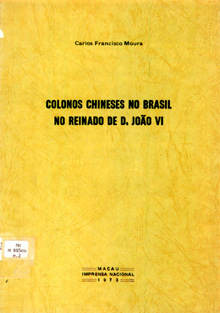
The fourteen stories that are included in the collection cover "nearly fourteen centuries of literary output, the reason for which this collection witnesses not only the development of fundamental themes and the narrative techniques of the Chinese novel, but also the versatility and genius of its most distinguished masters. 14 A brief historical introduction to each of the Dynasties is followed by a few stories: heroic tales from the Tang Dynasty (616-907), stories from the Song Dynasty (900-1276), which is the most significant period in Chinese Literature considering that story tellers reached their zenith at this time. To represent the Ming Dynasty (1368-1644), Alda de Carvalho Ângelo chose two stories that tell of the society of the time. Texts from Contos Fantásticos do Gabinete Leão (Fantastic Stories from the Lion's Den), by Pu Song Ling, originating from Chinese folklore, were selected from the Qing Dynasty (1644-1912). The introduction to the modem period, with Lu Xun stories, reveals another genre of Chinese Literature, Literature of the Revolution. Once this writer was driven by ideological motives he frequently changed the context or the characters of traditional stories to suit his needs.
However, Alda de Carvalho Ângelo's contribution to the understanding of Eastern lands was not limited to this collection of stories. Fragmentos do Oriente (Contos, Viagens, Culinária) was published in São Paulo in 1965, almost nineteen years after having left China, 15 in memory of her mother who died that year. The book has a richer general content than the title suggests. In the various stories, the author makes different analyses and gives much historical, demographical, ethnographical and geographical information.
The book is styled like memoirs and mentions many aspects of Macanese life at different dates, just as it mentions Hong Kong, India and Singapore. On a journey through time and space, it follows the path of the heroine who goes from childhood to maturity and having left Macao, she returns there through her memories. Her book, which ponders death and the meaning of life, does not open with a Christian text but with Oriental Philosophy: excerpts from Daoist Philosophy, translated into Portuguese by a fellow countryman, Manuel da Silva Mendes. From this point on, Oriental Philosophy often appears, especially when remembering the education she received.
The reading of these memoirs presupposes a permanent intertextuality which oscillates between the West and the East and the various Orientals living in Macao. The author is a living example: the Chinese, the 'sons and daughers of the soil', the Indian families with whom she lived since childhood and made the journey to this Country. We still can not piece together her family tree, mainly the Macanese side, and work out her 'ethnic' origins: Chinese, Malay, Indian, African? These are questions which remain unanswered.
Alda de Carvalho Ângelo leaves nothing to chance with her judicious selection of material. Natural phenomena, such as a tornado, as well as cultural phenomena, like the history of Macao, are included in some way. As she said "it is part of the aim of this work to bring a little bit of everything over here."16 She sorts and organises as though she were dealing with a living catalogue of memories which she later develops along with some of her observations. She essentially spends time on the human being and the environment he lives in. Landscape did not interest her a great deal. However, in any area related to people, she is precise in the portrait she draws and the colours she paints.
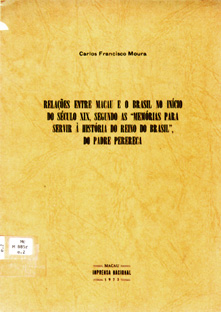
The narrative has a strong tendency to digress; from the outer to the inner, from the inner to the outer, from the inhabitant to the habitat, returning to the beginning again, giving meaningful descriptions of details, showing a deep cultural awareness. People are set against objects and things. When it comes to enumeration and precise, exact description, which is often detailed, subjective commentaries that stem from observations are often interlaced with profound personal experience. The known is set against the unknown, actions against characters, and characters against objects. In most cases, aspects of the exotic are called upon and communicated in its many facets. It is Language that introduces the West, the social and cultural points (Cuisine, War, death rituals, traditional festivals, religion, work, everyday life at home and in the streets) and the many situations she describes.
The author often functions as a narrator who shows authority and complete knowledge on all subjects, even when linguistic competence is referred to: "We spoke one minute in Portuguese, then in Chinese and then in English."17 Whenever the reader has problems understanding or forming concrete facts, the narrator interprets and explains in a parallel text, using rich and meaningful metalanguages. She shows a rigouress approach in her descriptions: in magical practices or prayers for curing, 18 in regional costume, etc. Here is an example: "Young girls and old ladies [...] in brand new chéon sám [changshen]长衫 or tunics and long trousers, [...] the young maids with traditional hap ló [he luo] 盒箩 (elegant round wooden boxes with compartments) suspended from their arms."19With regard to food and weights she says: "Well you see,'coconut cabbage' just means 'ordinary cabbage', and a catty is a small weight measurement. In Chinese it is a cân [jin]斤. A pico is one-hundred catties and a catty is sixteen taéis (tael in the singular). A kilo is one catty and ten taéis. "20 As far as the rest of the text is concerned, she gives explanations in footnotes on different ideas, words and customs. 21 Although she uses many Chinese expressions, she uses Macanese words with greater frequency.
Alda Ângelo chose everything that best represented Macao. She paid special attention to the Chinese population and their festivals and celebrations of both life and death. Celebrations for Chinese New Year and the fifteenth day of the eighth lunar month, along with death rituals and remembrances of their forefathers, take up entire pages of the book. The sights, smells and meanings of each celebration are described in detail.
Two lines of activity are always followed: one is outside, on the streets, in the boats, around the City, in the temple or at the beach; the other is inside, at home, at the temple...
Starting chronologically with the first of the five days in Chinese New Year, she gives precise information as to the order of events. She describes daily life at this time of year: the crowded roads, what is eaten, worn and bought, given, received and seen. And then comes the unforgettable spectacle of the procession of the Dragon: the revolving City, the excitement surrounding all those participating and throwing panchões. Sometimes comparisons are made with the typical Portuguese festivals that were taken to Brazil. Such is the case with the São João (St. John) festivities. The rituals imposed on the lady of the house during this same period are brought to life: the entertaining of guests, the food, the special decoration of the house. The detailed descriptions full of personal observations are attentive to those who are part of the culture and those who understand it. More is portrayed than just the outdoor scenes with striking colours, strong and exotic smells, loud noises and gestures laden with meaning. Every last detail is rigorously noted down and described, nothing being allowed to escape.
It is clearly meant for Brazilian readers, above all where gastronomic matters are concerned: recipes are given and substitute ingredients or seasoning, available in Brazil, are suggested. However, black magic is also portrayed with the skill of someone who would appear to have personally experienced it. All the most representative dishes of Chinese and Macanese Cuisine are spoken of, immediately warning the reader that, if described in detail, an entire book could be filled.
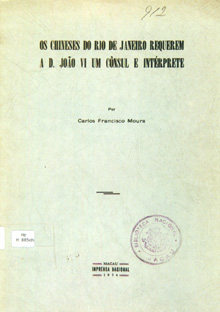
With preparation of food for the individual in mind, a journey to the culaus (local restaurants) and their employees is set out. They are described in detail, as are the various exotic dishes that can be eaten there, paying particular attention to specialities like gui-chi-tong [yu chi tang] 鱼翅溏 (shark fin soup) and pei-tan [pi dan]皮蛋(black eggs). Furthermore, the best time to go, whether just to eat, or to gamble and then eat, is explained. Splendid accounts of food and its preparation, its tastes and ingredients are given to us and frequent comparisons to Western Cuisine and customs are made. As food is not the only requirement in life, a series of customs related to its preparation, such as smoking, methodology, prayers and occult customs, are also referred to. Tám-chi-châi [Tang zhu zhai]烫猪仔 magic, which literally translated means 'singed piglets' or savan (warding of the 'evil eye') are everyday customs in Chinese houses in Macao and probably in some Macanese houses too. Alda's mother looked for assistance in her household book of witchcraft since she did not want to trouble her husband. The maids and amah, using sayings and mysterious noises and aided by the magical leaves of peach-tree, wormwood, mango-shrub and rosemary, helped Alda and her siblings to be free of all evil. But worse than all these evils, is the hard and unfair life of the coolie who pulls rickshaws through the streets of Macao. His impoverished life, full of misery and bitterness, passes away in the heat and humidity which slowly destroys him from dawn until the following day. Alda Ângelo chose one, if not the toughest profession in Macao for her memoirs and she documents it with a short story full of sadness and drama. It moves from life through to death, their ceremonies being described in full. She describes the selection of the future dwelling of the deceased, the departure from his house to his final resting place, the procession of mourners, the coffin which is very different from its Western equivalent, the music and banquet throughout the night. Those who accompany him to his final resting place are dressed in white. The procession is made up of relatives, friends, acquaintances and curious followers of the group of musicians. They carry lanterns on their shoulders, altars with sumptuous delicacies, flowers, models of objects made out of paper resembling things that will be of use to the deceased in the next world: a car, clothes, shoes, money, etc. A photograph of the dead man is also placed on his coffin. Finally everything is burnt so that his mortal remains accompany his spirit. Food is left next to the tomb and it is replaced from time to time throughout the year so as the dead need lack for nothing.
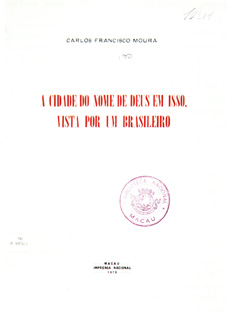
These ceremonies, so different from our own, are also a wealthy testimony to the traditional roles within the family, most of all of the eldest son, since women, daughters or wives are not included in these rites. However, the functions of the Buddhist priest and the many complicated customs at home, in the street, at the temple and at the tomb are described. Everything is explained in this description: the choice of the future home of the deceased by the monks, the clothes of the living, the offerings. As has already been mentioned, it falls to the son, so coveted by the father, to continue his forefather's name and to fulfil all the complicated funeral rituals. In a story entitled A estela dos antepassados (The Stele Of The Forefathers), by Luís Gonzaga Gomes, based on filial devotion, these and many other aspects related to the theme of death are unfolded.
Another side of these memoirs is concerned with Alda de Carvalho Ângelo's life as a young woman and the time she spent in Kowloon: the difficult period of War, the fear and panic that existed then, the arrival of refugees in Macao, the concentration camps in Hong Kong, the dramatic stories of friends. All these aspects have been looked at by other writers and researchers.The War era, for example, brings to mind A história na bagagem (The history in the luggage)22 by Luís Andrade de Sá, which were reconstructions of old texts, although not entirely so. And other authors, in a more or less thorough way and with different objectives and styles, later deal with some of the points developed by Alda in her book. Ana Maria Amaro, Graciete Batalha and Cecília Jorge among others, make a point of contact with the work of Alda de Carvalho Ângelo. For example, Graciete Batalha, in her book Bom Dia, S'tora (Good Morning, S'tora)' 23leaves us the Diary of a more recent era, accompanied by War, which could have been read as a continuation of Alda de Carvalho's text of memoirs, being to a certain extent its precursor.
Regarding these books and many other different aspects of Macanese life it is always possible to find, in more recent writers, a certain type of continuity especially where Macanese Cuisine and the secret world of spices are concerned. One just has to look at contemporary Portuguese and Macanese works, which are more or less set out below. 24
The books of Alda de Carvalho Ângelo are, without doubt, of great importance to the understanding of Macanese culture. For this reason they can never, and should never, be forgotten. **
Translated from the Portuguese by: Louisa Hoyer-Millar.
CHINESE GLOSSARY
cân - see: jin.
changshen [chéon sám] 长衫
chéon sám - see: changshen.
gui-chi-tong - see: yu chi tang.
jin [cân] 斤
hap ló - see: he luo.
he luo [hap ló] 盒箩
pai-tan - see: pi dan.
pi dan [pai-tan] 皮蛋
tám-chi-châi - see: tang zhu zai.
tang zhu zai [tám-chi-châi] 烫猪仔
yu chi tang [gui-chi-tong] 鱼翅溏
NOTES
** We acknowledge our gratitude to Dr. Isaú Santos and Dr. Júlio Nogueira for information essential to the conclusion of this essay. We are equally indebted to Prof. Mário Lages for his critical advice. ALL PHOTOGRAPHS COURTESY OF DR. CARLOS FRANCISCO MOURA
1 PEREIRA, João Feliciano Marques, Subsídiós para o estudo dos dialectos crioulos do Extremo Oriente; textos e notas sobre o dialecto de Macau, in "Ta-Ssi-Yang-Kuo", Macau, Instituto Cultural de Macau, ser. 1,1(1) Oct. 1984, p.56 [2nd edition].
2 GOMES, Luís Gonzaga, Bibliografia Macaense, Macau, Instituto Cultural de Macau, 1987, p.202 [2nd edition].
3 EDMONDS, Richard Louis, Macao, (World Bibliographical Series), Oxford, Clio Press, 1984; GOMES, Luís Gonzaga, op. cit.; Macau letras e artes do século XVI ao século XX, Lisboa, Biblioteca Nacional, 1979.
4 BATALHA, Graciete Nogueira, Poesia tradicional de Macau: os poetas populares macaenses, in "MacaU", Macau, (4) Ago. [August] 1987, p.41.
5 Ibidem.
6 GOMES, Luís Gonzaga, op. cit., p. 14.
7 ÂNGELO, Aldo de Carvalho, Fragmentos do Oriente (Contos, Viagens, Culinária), São Paulo, A. C. Ângelo, 1965, p.141.
8 Idem., p.66.
9 ÂNGELO, Alda de Carvalho et al, trans., Maravilhas do conto chinês, São Paulo, [p. n. n.], [n. d.].
10 ÂNGELO,1965, op. cit..
11 LOPES, Ana Maria Costa, O catálogo dos livros chineses; versões em português, in "Revista de Estudos Luso-Asiáticos", Macau, (1) Set. [Sept.] 1992, pp.84-96.
12 ÂNGELO, et al, op. cit.
13 RHEDEL, Diaulas, ed.. Contos chineses, [t. n. n.], Ediouro-Tecnoprint, [n. d.], p.202.
14 ÂNGELO, et al., [n. d.], op. cit..
15 ÂNGELO, 1965, op. cit., p. 15.
16 Idem., p.71.
17 Idem., p.118.
18 Idem., p.62-63, 65.
19 Idem., p.18.
20 Idem., p.82.
21 Idem., p.36.
22 SÁ, Luís Andrade de, A história na bagagem: crónicas dos velhos hotéis de Macau, Macau, Instituto Cultural de Macau, 1989, p. 151.
23 BATALHA, Graciete Nogueira, Born dia, S'tora: diário de uma professora em Macau, Macau, Instituto Cultural de Macau, 1991, p.424.
24 111 receitas de cozinha chinesa: receitas da avó Roalina, Mem Martins, Europa-América, 1990 [2nd edition]; CELESTINA, Bons petiscos, Macau, Centro de Informação e Turismo, 1977 [2nd edition]; GOMES, Maria Margarida, A cozinha macaense, Macau, Imprensa Nacional, 1984.
* MA in Asiatic Studies. Former Lecturer at the Universidade de Macau (University of Macao), Macao. Presently lecturing at the Centro de Estudos dos Povos e Culturas de Expressão Portuguesa (Centre for Studies on Peoples and Cultures of Portuguese Expression), Universidade Católica Portuguesa (Portuguese Catholic University), Lisbon. Organizer of an anthology of traditional Portuguese folk stories. Author of O conto regional na imprensa periódica de 1875-1930 (Regional Folk Tales in the Daily Press from 1875 to 1930), Sequências narrativas no conto popular português (Narrative Sequels in Portuguese Popular Folk Tales), and Alguns casos patológicos na literatura erudita do século XIX (Some Pathological Cases in the Erudite Literature of the Nineteenth Century).
start p. 112
end p.